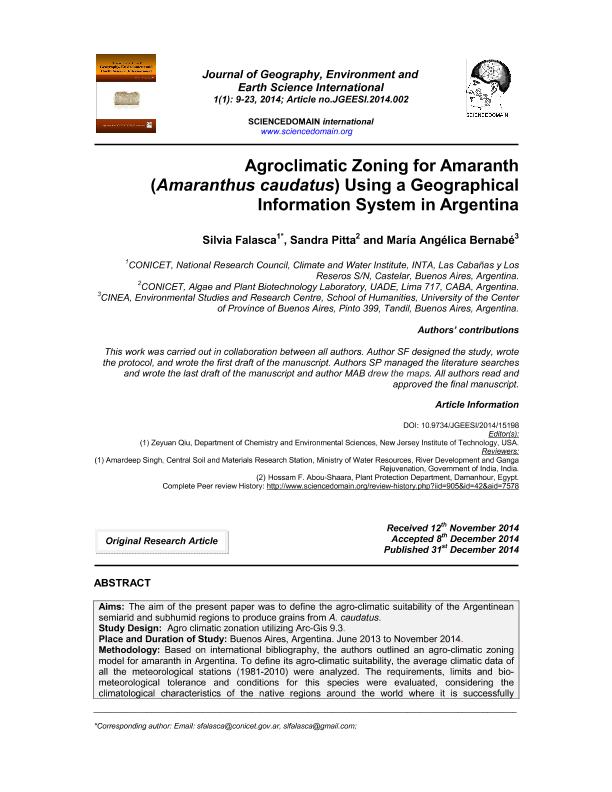Mostrar el registro sencillo del ítem
dc.contributor.author
Falasca, Silvia Liliana

dc.contributor.author
Pitta Alvarez, Sandra Irene

dc.contributor.author
Bernabé, María Angélica

dc.date.available
2018-01-12T19:13:35Z
dc.date.issued
2014-12
dc.identifier.citation
Bernabé, María Angélica; Falasca, Silvia Liliana; Pitta Alvarez, Sandra Irene; Agroclimatic Zoning for Amaranth (Amaranthus caudatus) Using a Geographical Information System in Argentina; SCIENCEDOMAIN international; Journal of Geography, Environment and Earth Science International; 1; 1; 12-2014; 9-23
dc.identifier.issn
2334-2447
dc.identifier.uri
http://hdl.handle.net/11336/33120
dc.description.abstract
Aims: The aim of the present paper was to define the agro-climatic suitability of the Argentinean semiarid and subhumid regions to produce grains from A. caudatus. Study Design: Agro climatic zonation utilizing Arc-Gis 9.3. Place and Duration of Study: Buenos Aires, Argentina. June 2013 to November 2014. Methodology: Based on international bibliography, the authors outlined an agro-climatic zoning model for amaranth in Argentina. To define its agro-climatic suitability, the average climatic data of all the meteorological stations (1981-2010) were analyzed. The requirements, limits and bio-meteorological tolerance and conditions for this species were evaluated, considering the climatological characteristics of the native regions around the world where it is successfully cultivated. To obtain the maps, a series of previously interpolated bioclimatic variables were used. The agro-climatic indices, which determine different classes of suitability, were integrated in a Geographic Information System to create thermal and moisture regions. The maps elaborated (frost-free days, annual rainfall, annual temperature and average temperature during growing period), were superimposed to determine the agroclimatic zoning. Results: Nine classes of agroclimatic suitability under three different climatic conditions were delineated: humid, subhumid and semiarid. Agro-climatic zoning identifies areas with different potential yields, as per their environmental conditions. This is an innovative work, made by the implementation of a Geographic Information System that can be updated by further incorporation of complementary information. Conclusion: Because of its low hydric requirements, amaranth is a promising dry land crop for farmers in subhumid and semiarid areas of Argentina. Its cultivation would also be recommendable in optimal, very suitable and suitable areas under humid climate on moderately-highly saline soils and moderately alkaline soils, so as not to displace the traditional crops of Humid Pampas. This model may be applied in any part of the world, using the agroclimatic limits presented in this paper.
dc.format
application/pdf
dc.language.iso
eng
dc.publisher
SCIENCEDOMAIN international
dc.rights
info:eu-repo/semantics/openAccess
dc.rights.uri
https://creativecommons.org/licenses/by-nc-sa/2.5/ar/
dc.subject
Amaranth
dc.subject
Bioclimatic Requirements
dc.subject
Agroclimatic Zoning
dc.subject
Subhumid to Semiarid Climate
dc.subject
Argentina
dc.subject.classification
Otras Ciencias Biológicas

dc.subject.classification
Ciencias Biológicas

dc.subject.classification
CIENCIAS NATURALES Y EXACTAS

dc.title
Agroclimatic Zoning for Amaranth (Amaranthus caudatus) Using a Geographical Information System in Argentina
dc.type
info:eu-repo/semantics/article
dc.type
info:ar-repo/semantics/artículo
dc.type
info:eu-repo/semantics/publishedVersion
dc.date.updated
2018-01-11T19:35:57Z
dc.journal.volume
1
dc.journal.number
1
dc.journal.pagination
9-23
dc.journal.pais
India

dc.description.fil
Fil: Falasca, Silvia Liliana. Instituto Nacional de Tecnología Agropecuaria. Centro de Investigación de Recursos Naturales. Instituto de Clima y Agua; Argentina. Consejo Nacional de Investigaciones Científicas y Técnicas; Argentina
dc.description.fil
Fil: Pitta Alvarez, Sandra Irene. Universidad Argentina de la Empresa; Argentina. Consejo Nacional de Investigaciones Científicas y Técnicas; Argentina
dc.description.fil
Fil: Bernabé, María Angélica. Universidad Nacional del Centro de la Provincia de Buenos Aires. Facultad de Ciencias Humanas. Departamento de Ciencias Ambientales. Centro de Investigación y Estudios Ambientales; Argentina
dc.journal.title
Journal of Geography, Environment and Earth Science International
dc.relation.alternativeid
info:eu-repo/semantics/altIdentifier/doi/http://dx.doi.org/10.9734/JGEESI/2014/15198
dc.relation.alternativeid
info:eu-repo/semantics/altIdentifier/url/http://sciencedomain.org/abstract/7578
Archivos asociados
